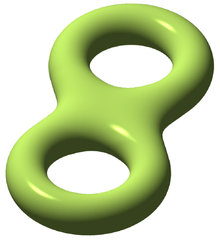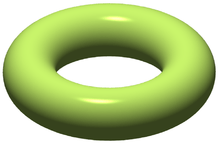Genus (mathematics)

In mathematics, genus (plural genera) has a few different, but closely related, meanings. The most common concept, the genus of an (orientable) surface, is the number of "holes" it has. This is made more precise below.
Topology
Orientable surface

The genus of a connected, orientable surface is an integer representing the maximum number of cuttings along non-intersecting closed simple curves without rendering the resultant manifold disconnected.[1] It is equal to the number of handles on it. Alternatively, it can be defined in terms of the Euler characteristic χ, via the relationship χ = 2 − 2g for closed surfaces, where g is the genus. For surfaces with b boundary components, the equation reads χ = 2 − 2g − b. In layman's terms, it's the number of "holes" an object has ("holes" interpreted in the sense of doughnut holes; a hollow sphere would be considered as having zero holes in this sense). A doughnut, or torus, has 1 such hole. A sphere has 0. The green surface pictured above has 2 holes of the relevant sort.
For instance:
- The sphere S2 and a disc both have genus zero.
- A torus has genus one, as does the surface of a coffee mug with a handle. This is the source of the joke that "topologists are people who can't tell their donut from their coffee mug."
An explicit construction of surfaces of genus g is given in the article on the fundamental polygon.
- Genus of orientable surfaces
 genus 0
genus 0 genus 1
genus 1 genus 2
genus 2 genus 3
genus 3
In simpler terms, the value of an orientable surface's genus is equal to the number of "holes" it has.[2]
Non-orientable surfaces
The non-orientable genus, demigenus, or Euler genus of a connected, non-orientable closed surface is a positive integer representing the number of cross-caps attached to a sphere. Alternatively, it can be defined for a closed surface in terms of the Euler characteristic χ, via the relationship χ = 2 − k, where k is the non-orientable genus.
For instance:
- A projective plane has non-orientable genus one.
- A Klein bottle has non-orientable genus two.
Knot
The genus of a knot K is defined as the minimal genus of all Seifert surfaces for K.[3] A Seifert surface of a knot is however a manifold with boundary, the boundary being the knot, i.e. homeomorphic to the unit circle. The genus of such a surface is defined to be the genus of the two-manifold, which is obtained by gluing the unit disk along the boundary.
Handlebody
The genus of a 3-dimensional handlebody is an integer representing the maximum number of cuttings along embedded disks without rendering the resultant manifold disconnected. It is equal to the number of handles on it.
For instance:
- A ball has genus zero.
- A solid torus D2 × S1 has genus one.
Graph theory
The genus of a graph is the minimal integer n such that the graph can be drawn without crossing itself on a sphere with n handles (i.e. an oriented surface of genus n). Thus, a planar graph has genus 0, because it can be drawn on a sphere without self-crossing.
The non-orientable genus of a graph is the minimal integer n such that the graph can be drawn without crossing itself on a sphere with n cross-caps (i.e. a non-orientable surface of (non-orientable) genus n). (This number is also called the demigenus.)
The Euler genus is the minimal integer n such that the graph can be drawn without crossing itself on a sphere with n cross-caps or on a sphere with n/2 handles.[4]
In topological graph theory there are several definitions of the genus of a group. Arthur T. White introduced the following concept. The genus of a group G is the minimum genus of a (connected, undirected) Cayley graph for G.
The graph genus problem is NP-complete.[5]
Algebraic geometry
There are two related definitions of genus of any projective algebraic scheme X: the arithmetic genus and the geometric genus.[6] When X is an algebraic curve with field of definition the complex numbers, and if X has no singular points, then these definitions agree and coincide with the topological definition applied to the Riemann surface of X (its manifold of complex points). For example, the definition of elliptic curve from algebraic geometry is connected non-singular projective curve of genus 1 with a given rational point on it.
By the Riemann-Roch theorem, an irreducible plane curve of degree d has geometric genus
where s is the number of singularities when properly counted.
See also
References
- ↑ Munkres, James R. Topology. Vol. 2. Upper Saddle River: Prentice Hall, 2000.
- ↑ http://mathworld.wolfram.com/Genus.html
- ↑ Adams, Colin (2004), The Knot Book: An Elementary Introduction to the Mathematical Theory of Knots, American Mathematical Society, ISBN 0-8218-3678-1
- ↑ Graphs on surfaces.
- ↑ Thomassen, Carsten (1989). "The graph genus problem is NP-complete". Journal of Algorithms. 10 (4): 568&ndash, 576. doi:10.1016/0196-6774(89)90006-0. ISSN 0196-6774. Zbl 0689.68071.
- ↑ Hirzebruch, Friedrich (1995) [1978]. Topological methods in algebraic geometry. Classics in Mathematics. Translation from the German and appendix one by R. L. E. Schwarzenberger. Appendix two by A. Borel (Reprint of the 2nd, corr. print. of the 3rd ed.). Berlin: Springer-Verlag. ISBN 3-540-58663-6. Zbl 0843.14009.